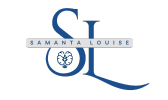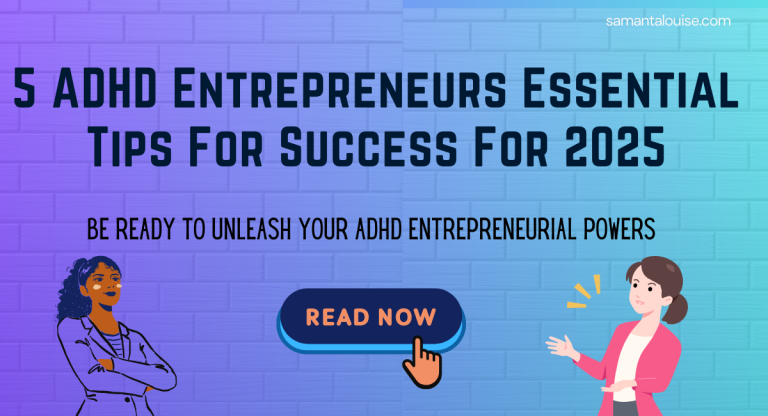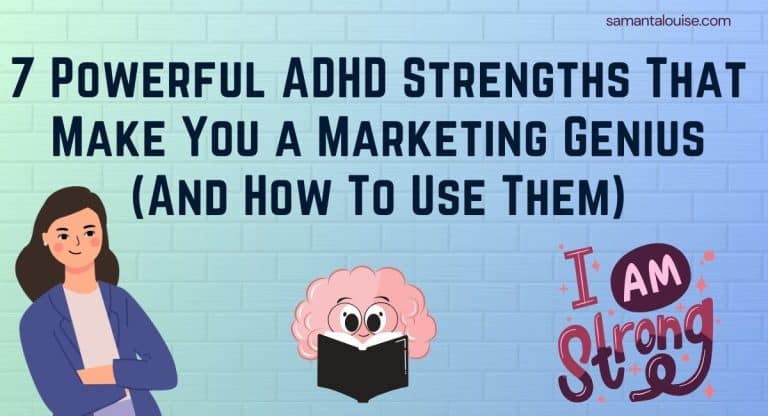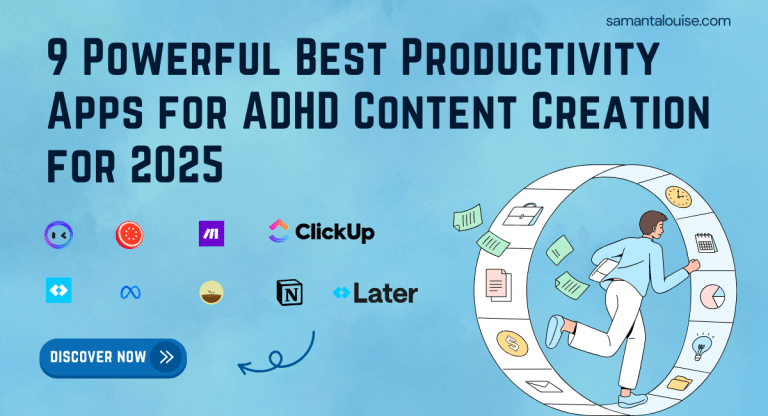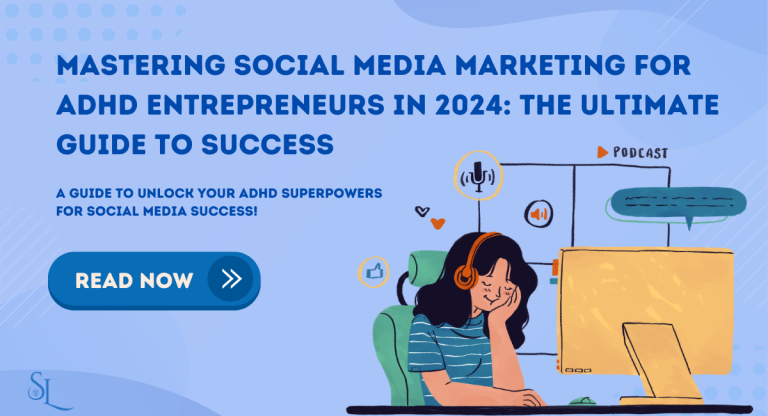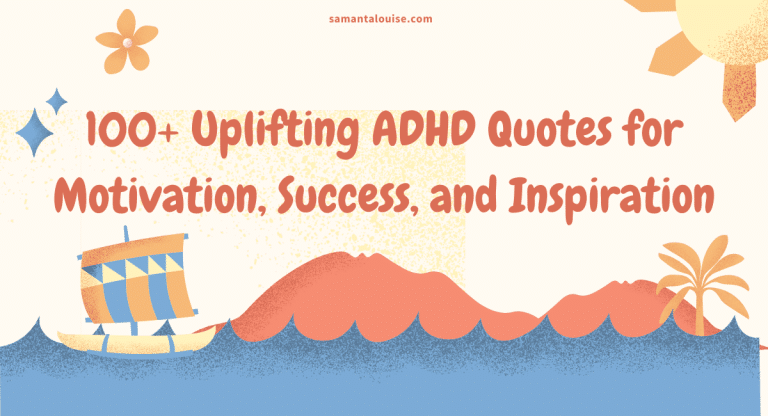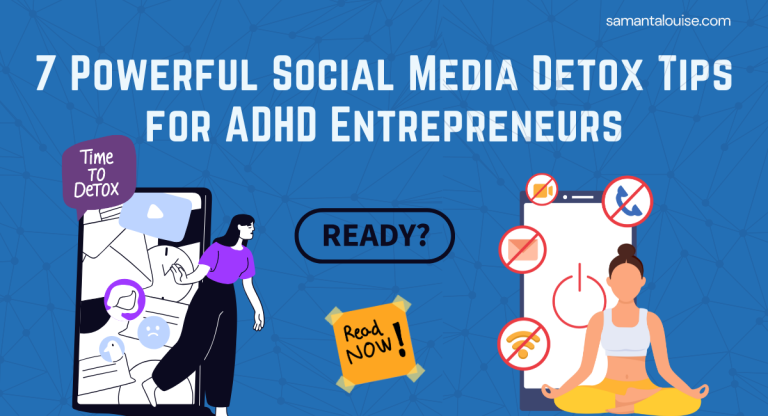7 Powerful Minimalist Social Media Hacks for ADHD Entrepreneurs
Do you sometimes feel overwhelmed by the constant pressure to show up online while facing your ADHD challenges? You’re not alone. Many entrepreneurs with ADHD struggle with maintaining a consistent social media presence without burning out including myself at the beginning.
But here’s the truth: You don’t need to post three times a day or be on every platform to succeed. What you need is a minimalist strategy that works with your brain, not against it.
In this comprehensive guide, I’ll share 7 effective and brilliant hacks I use for a minimalist social media approach in my business and work as a digital marketer. Before I became a social media minimalist, I was always anxious about being “on” all the time but now, I can finally breathe and do social media marketing work effectively.
Whether you’re starting fresh or rebuilding after a severe ADHD burnout, this minimalist approach will help you create a sustainable social media presence that grows your business without overwhelming you. Let’s turn your social media from a source of stress into a manageable, effective marketing tool.

What is Digital Minimalism in the Social Media Context
Digital minimalism social media isn’t just another buzzword from the wellness industry, it’s a lifeline, especially for ADHD entrepreneurs or marketers who feel overwhelmed by the constant noise. At its core, it’s about intentionally reducing your digital footprint to focus on what truly matters for your business growth.
It is a bit like decluttering your closet but for your online world. The digital declutter process starts with a simple question: “What actually moves the needle in my business?” This is the first question you should ask yourself on your way to digital overwhelm reduction.
Here’s why traditional social media methods often fail ADHD entrepreneurs: They’re built on the assumption that more is better. More posts, more platforms, more engagement but this environment can be extremely toxic for the general wellbeing of people with ADHD.
I’ve found that the core principles of social media minimalism boil down to three key elements:
- Platform Minimalism: Choose one or two platforms where your audience actually hangs out. I’ve seen better results from focused excellence on one platform than mediocre presence on five. This strategic platform focus is crucial for maintaining consistency.
- Content Efficiency: Implement a minimalist posting schedule that you can actually sustain. Quality trumps quantity every single time.
- Systematic Simplification: Create ADHD-friendly workflows that reduce decision fatigue. This means setting up streamlined workflows and embracing social media automation where it makes sense.
I’ve learned that the most effective minimalist social media strategy isn’t about doing more with less; it’s about doing less, better. This shift toward digital minimalism isn’t just about productivity, it’s about creating a sustainable, long-term approach to social media that actually feels good. And isn’t that what we’re all really looking for?
How Does a Minimalist Social Media Approach Help ADHD Entrepreneurs
You know that feeling when you open your social media accounts and immediately feel your brain short-circuit? I’ve been there, and it’s exactly why I became obsessed with finding a better way for entrepreneurs like us to manage social media without the overwhelm.
Before adopting a minimalist social media, here’s what would usually happen to me: Sit down to create content, get distracted by a notification, spend 45 minutes down a rabbit hole, and end up with nothing posted. Sound familiar? This is where ADHD social media management techniques become absolutely crucial.
Our brains, especially those with unique ADHD executive function patterns, aren’t wired to handle the constant context-switching that traditional social media demands. This is where mindful digital presence becomes crucial. Instead of being everywhere, doing everything, we focus on creating an intentional online engagement strategy that actually works with our brain’s natural patterns.
A minimalist social media approach might lead to more focus, less decision fatigue and sustainable growth online. By creating ADHD-friendly workflows and embracing platform simplification, we’re working with our natural tendencies rather than against them. Here are some efficiency systems that I use for my digital business:
- Content batching for ADHD: Create in sprints when your focus is high
- Minimal content planning: Use templates and systems instead of reinventing the wheel
- Content repurposing method: Get more mileage from less content creation
The goal of digital minimalism social media isn’t to do less for the sake of doing less – it’s about being more intentional with your energy and attention. By focusing on sustainable social strategy and minimalist metrics, you can build a social media presence that grows your business without overwhelming your mind.
7 Game-Changing Minimalist Social Media Hacks
Let’s explore the 7 hacks I have been using for a minimalist social media approach in my business and social media marketing work. I have learned and implemented these techniques or methods to manage my social media more effectively without feeling guilty about not putting in enough effort.
Hack #1: Use less social media platforms for digital presence
Many social media marketers or entrepreneurs make the mistake of thinking they should be everywhere on social media. Instead, you just need to be where your leads or audience usually hang out the most.
If you have a team of 5-10 people working with you, being everywhere should not be a problem (technically) but just imagine being a solopreneur and having to manage 5 different platforms on top of your ADHD… It is smarter and more efficient to choose the best platforms to establish your online presence.
Start by conducting a social media audit to find out where your leads come from for two weeks – what main social media platforms do they use? Then you should choose your primary platform based on your business operations. You can use this framework:
- B2B services → LinkedIn
- Visual products → Instagram/Pinterest
- Community building → Facebook
- Quick updates/news → X (Twitter)
The key is to resist the urge to cross-post everywhere. Instead, invest that energy into mastering the nuances of your chosen platform’s algorithm and audience expectations.
Hack #2: Adopt The 1-3-5 Content Framework
The 1-3-5 content framework has been effective for content creation management in my social media marketing journey. Here is how it works:
1 = One core piece of long-form content weekly (blog post, video, or podcast)
3 = Three key messages derived from that content
5 = Five different ways to share those messages
Implement this through content batching for ADHD:
- Monday: Create your core piece
- Tuesday: Break it down into three key points
- Wednesday-Friday: Transform these points into different formats
Use a content bank system to store ideas and partially completed posts. I recommend using Notion for this.
Hack #3: Use the 60-Minute Power Routine
The key to making this work is what I call strategic time-blocking social media. Here’s my routine:
Morning Power Hour (25 minutes):
- Check notifications (10 mins)
- Respond to priority messages (8 mins)
- Schedule today’s content (7 mins)
Mid-day Engagement Block (25 minutes):
- Like and comment on 5-15 relevant posts
- Share one piece of valuable content
Evening Wrap-up (10 minutes):
- Review analytics
- Queue tomorrow’s content
- Log off completely
You can customize this timer according to your social media work needs but the key is to respect the time block for the activity. Use timer-based productivity to stick to these limits. Set actual timers – don’t trust yourself to track time mentally.
Hack #4: Streamline Your Social Media Tools
Creating an effective minimal tech stack is crucial for ADHD business systems. Here’s my tested tool suite:
Essential Tools:
- Content Planning: Notion
- Scheduling: Later
- Analytics: Later or native platforms analytics only
- Automation: Make
Implementation Strategy:
- Audit current tools
- Eliminate redundant ones
- Set up streamlined workflows – create checklists
- Create standard operating procedures (SOPs) or templates
Remember: More tools often mean more chaos. Stick to tools that serve multiple purposes and integrate well with each other.
Hack #5: Build Sustainable Social Media Habits
Creating ADHD-friendly workflows requires understanding your natural energy patterns. Here’s how to build sustainable habits:
1. Know when you are at your best
- Track when you’re most creative
- Identify your high-energy hours
- Plan content creation during these times
2. Implement boundaries
- No social media before 10 AM
- Set specific engagement hours
- Use app blockers during focus time
- Create a shutdown ritual
3. Manage your focus and attention
- Pomodoro method for content creation
- Time-blocking for engagement
- Regular digital detox days
Hack #6: Use the 3-2-1 Posting Method
I like this method because it is simple to implement and follow. This systematic approach simplifies your entire social media strategy:
Three Primary Content Types:
- Educational (teaching something valuable)
- Engaging (asking questions/starting conversations)
- Personal (sharing experiences/behind-the-scenes)
Two Engagement Periods:
- Morning: Content posting and initial engagement
- Evening: Response management and community building
One Daily Priority:
- Choose ONE main goal each day
- Focus all actions around that goal
- Track results for that specific objective
Hack #7: Implement a Daily Digital Detox Protocol
This is about creating intentional space between you and social media through social media boundaries:
1. Timeboxing Implementation:
- Use Screen Time limits on your phone
- Set up “Focus Mode” during work hours
- Create designated social media-free zones
2. Mobile Management:
- Remove social apps from your phone
- Use browser-only access
- Install website blockers
- Set up two-factor authentication to make impulsive checking harder
3. Additional Strategies:
- Use a social media accountability partner
- Schedule regular digital sabbaticals
- Create a “social media-free weekend” monthly
- Use grayscale mode on your devices
- Keep devices out of your bedroom
Don’t try to do everything at once. Pick one hack, master it for two weeks, and then add another. This creates sustainable change rather than overwhelming yourself with too many changes at once.
Essential Tools for Minimalist Social Media Management
As someone who’s tested countless tools (and wasted money on many), let me share the stripped-down, minimal tech stack that actually works for ADHD entrepreneurs. You do not need a lot of tools, in fact having a lot of them makes things more confusing and cumbersome. In my experience, you need only three categories of tools:
1. Content Management Tools
Choose only one of them depending on your situation. I prefer Notion as I work alone but if you manage a team, Clickup is the best.
- ClickUp ($9/month) – Best for visual planners
- Notion (Free) – Ideal for text-heavy content
- Trello (Free) – Perfect for kanban-style planning
Why these work for ADHD business systems:
- Visual organization
- Drag-and-drop interfaces
- Clear status tracking
- Built-in templates
2. Scheduling Tools
I use Later as it is great for visual content scheduling and comes with AI-powered features such as captionwriting. You can use Meta Business Suite as a native scheduling tool for Meta platforms.
- Later (Free plan available) – Best for visual content
- Buffer ($15/month) – Simplest interface
- SocialBee ($19/month) – Excellent for content recycling
Key features for ADHD social media management:
- Visual calendar view
- Bulk uploading
- Mobile-friendly interface
- Analytics integration
3. Graphics creation tools
Even if usually recommend to use one tool, I actually use two of those: Canva Pro and Capcut Pro.
- Canva (Free plan works fine) – Most versatile
- Clickdesigns ($47 Lifetime for Pro templates and graphics)
- Capcut Pro for videos
In addition to these three categories, you can use an automation tool to connect all three of these categories. My go-to platform is Make. It allows me to connect the platforms and seamlessly create content. The key is not finding more tools, but finding the right ones and using them effectively. Start with the basics and add only when necessary. Your ADHD brain will thank you for the simplicity, and your business will benefit from the focus.
Creating Your Long-Term Minimalist Strategy
A minimalist social media strategy sounds great but how do you maintain this approach in the long term? Steal my 8-week plan below. I did not start by doing it like this but through trial and error, I put this together to help ADHD entrepreneurs implement this easily:
Week 1: Foundation
- Delete unused social accounts
- Pick ONE or a maximum of 3 of your primary platforms
- Remove social apps from phones except primary platforms
- Set up one scheduling tool (Buffer/Later)
- Create one planning tool (Notion/ClickUp)
Week 2: System Setup
- Choose your daily time block (pick one) for engagement:
- Morning: 7-8 AM
- Midday: 12-1 PM
- Evening: 7-8 PM
- Set up a 60-minute workflow:
- 10 mins: Post content
- 5 mins: Engage
- 5 mins: Check metrics
Week 3: Content Structure
- Define 3 content pillars
- Create 2 post types per pillar
- Write one call-to-action template
- Set up a content bank in the chosen tool
Week 4-5: Habit Building
- Link social tasks to existing habits:
- Morning coffee → Check notifications
- After lunch → Engagement
- Evening routine → Planning
- Use a timer for all social media work
- Create content in batches weekly
- Schedule posts one week ahead
Week 6-8: Maintenance
- Weekly tasks:
- 3 main posts
- 2 engagement posts
- 1 personal update
- 15-min analytics review
- Monthly tasks:
- Clean up old content
- Update content bank
- Review analytics
- Adjust the schedule if needed
Overcoming Common Minimalist Strategy Challenges
There are some challenges you might face when trying to adopt a minimalist social media approach but here are the top ways to overcome those:
- Platform Changes & Adaptability
Managing social media platform changes doesn’t have to be overwhelming. Set a 15-minute monthly review of trusted industry news sources and create a simple implementation checklist. For ADHD-friendly adaptation, test changes on your personal account first and update one system at a time, documenting what works. - Building Consistent Routines
Support your ADHD executive function with visual reminders and time-blocking. Keep 3-5 emergency posts ready and save high-performing templates. Your ADHD business systems should include morning routine checklists and quick-access hashtag groups for efficiency. - Content Creation & Emergency Protocol
Build a robust content bank with 10 evergreen ideas, 5 personal story templates, and 3 promotional frameworks. For ADHD entrepreneurship success, use voice notes for ideas and maintain a client question database. When facing content drought, rely on behind-the-scenes posts, quick tips, or client success stories. - Recovery & Adaptation Strategies
When you miss posts, don’t apologize – simply restart using your emergency content. During low-energy periods, switch to a minimal posting schedule and leverage user-generated content. Keep backup posting methods and login information accessible for technical issues. Remember: sustainable rhythm matters more than perfect consistency.
What To Do If You Fail to Follow Through
First, recognize that setbacks are normal, especially with ADHD executive function challenges. Instead of viewing it as a failure, treat it as data. If you’ve fallen off track, start with a simple reset: archive unnecessary posts, delete unused apps, and choose ONE platform to focus on. The beauty of a minimalist social media approach is that you can always return to basics.
Consider this reset an opportunity to build stronger ADHD business systems. Maybe you need more automation, fewer posting times, or a simpler content strategy. Many successful ADHD entrepreneurs have rebuilt their social media presence multiple times before finding their sustainable rhythm.
The key is to restart with even clearer boundaries and reduced expectations. Focus on the minimum viable social media presence that serves your business, not what others are doing or what you think you “should” be doing.
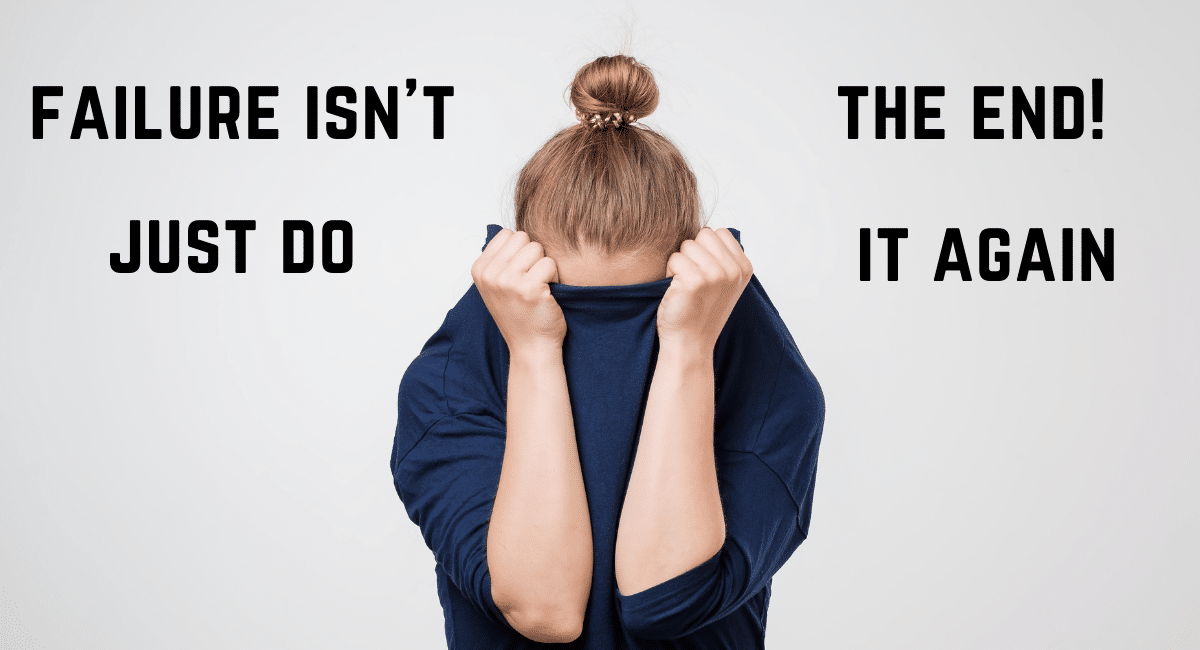
Final Words of Advice Before You Start
Transforming your social media approach doesn’t happen overnight, but with these minimalist strategies, you can create a sustainable system that works with your ADHD brain, not against it. Start with one platform, implement the 3-2-1 posting method, and gradually build your minimalist social media empire. Remember, less really is more when it comes to effective social media management.
Do not hesitate to use social media templates to save time. Automation tools are a must to avoid unnecessary and repetitive social media work. If you want to have monthly tips on how to do social media marketing the ADHD-friendly way, subscribe to my newsletter and get free resources monthly!
